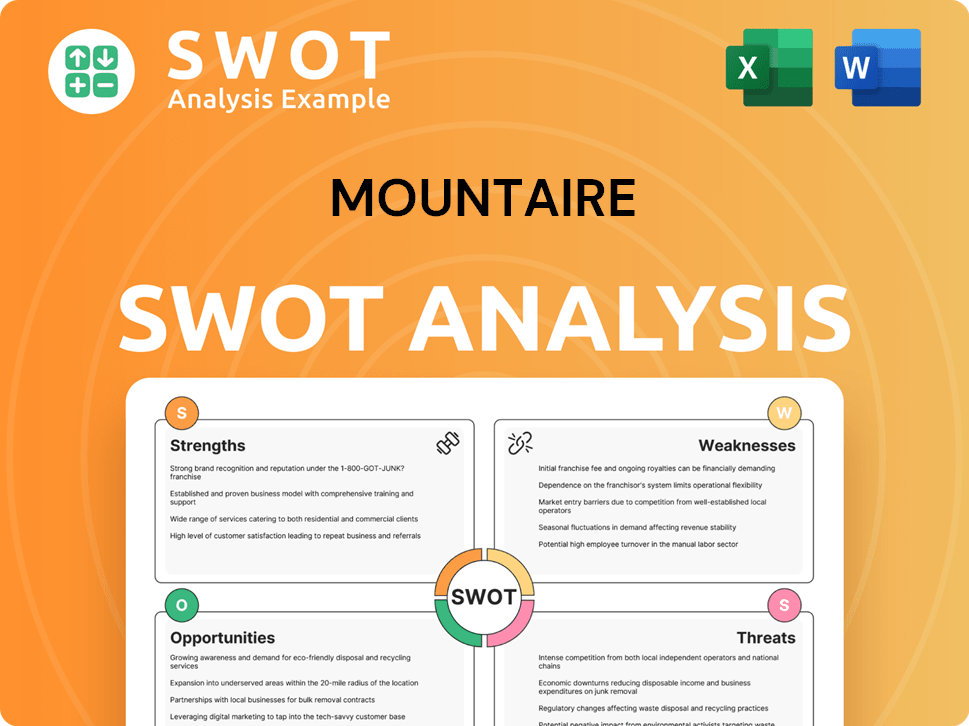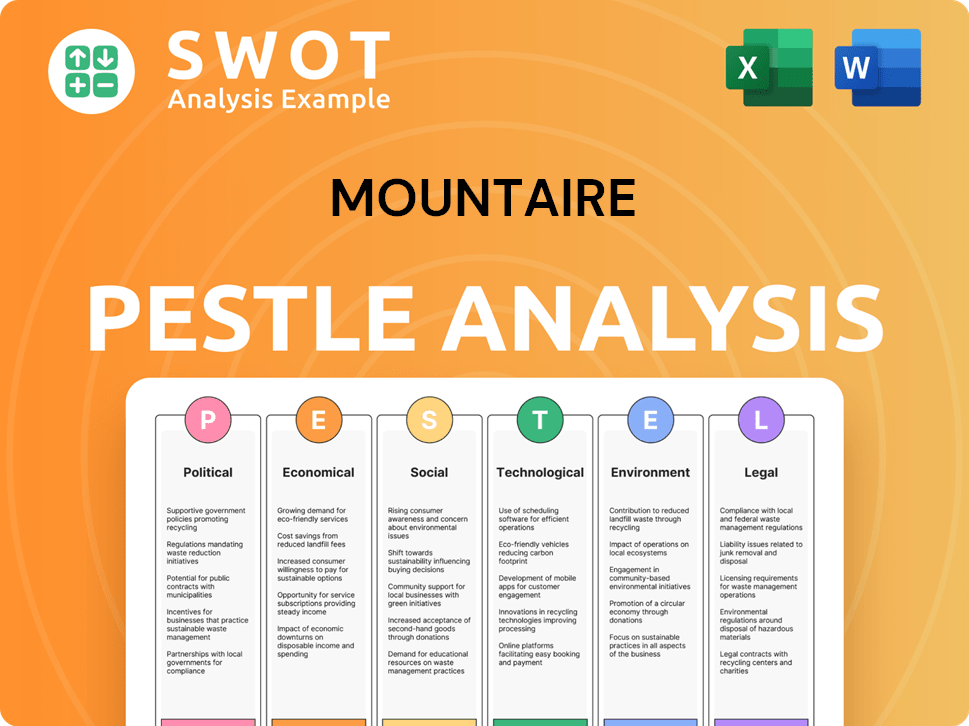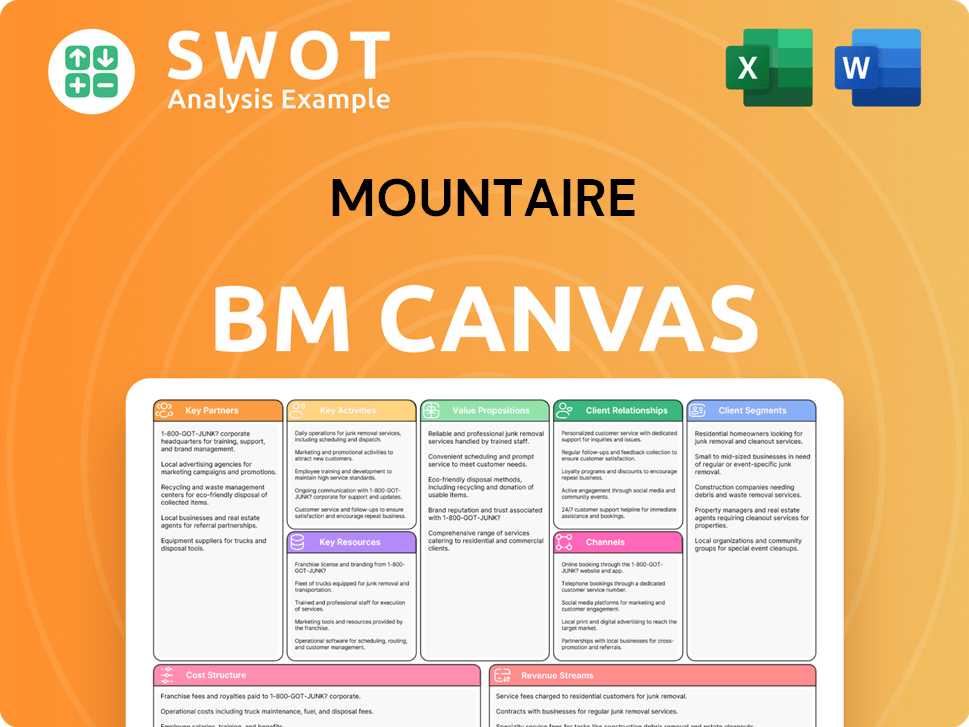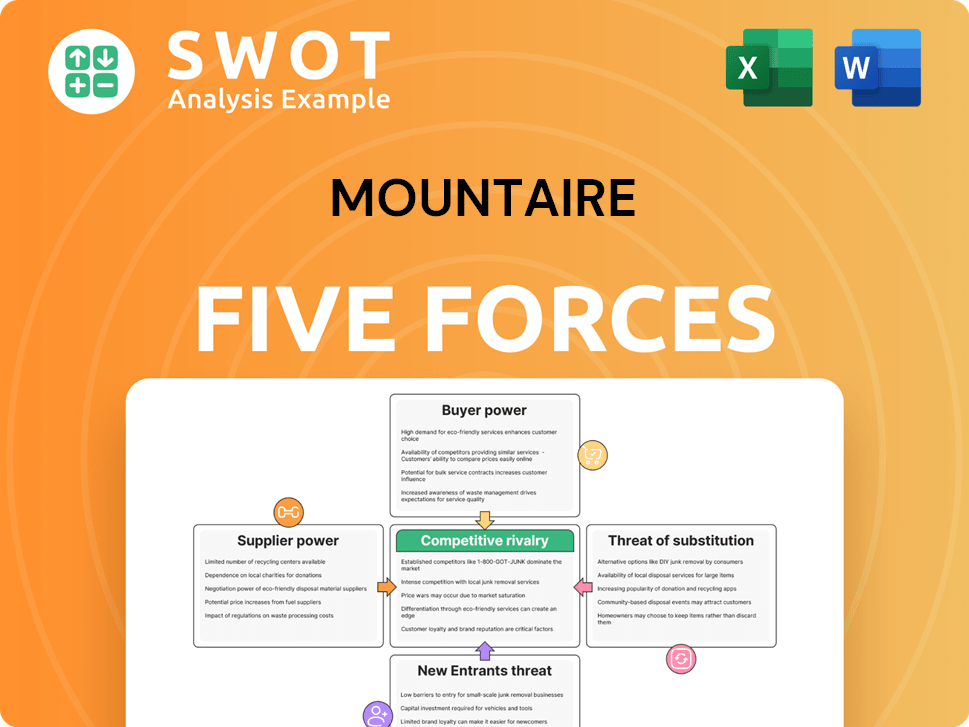Mountaire Bundle
How Does Mountaire Company Thrive in the Poultry Industry?
Mountaire Company, a major player in the food manufacturing sector, particularly in chicken production, is a fascinating case study. As the eighth-largest chicken company in the U.S., Mountaire Farms operates a fully integrated business model, from farm to fork, impacting farmers, employees, and consumers alike. Understanding its operations is key to grasping its market position and future prospects.

This exploration of Mountaire Company will dissect its core operations, from feed mills and hatcheries to processing plants, revealing how Mountaire chicken reaches consumers. We'll examine its value proposition, revenue streams, and strategic approaches in the competitive poultry processing landscape. For deeper insights, consider a detailed Mountaire SWOT Analysis to understand its strengths, weaknesses, opportunities, and threats, offering a comprehensive view of this significant food manufacturer.
What Are the Key Operations Driving Mountaire’s Success?
The core operations of the Mountaire Company, also known as Mountaire Farms, are centered around a vertically integrated model. This approach covers the entire process of poultry production, from breeding and raising chickens to processing and distributing their products. This comprehensive strategy allows for strict control over quality and efficiency throughout the production cycle.
The company's primary value proposition lies in providing high-quality poultry products to a diverse customer base. This includes retail consumers, food service providers, and industrial clients. Their commitment to quality and a wide range of products helps Mountaire Company stand out in the competitive food manufacturing industry.
Mountaire's operational processes are designed to ensure a consistent supply of high-quality chicken products. The process begins with sourcing grains for feed mills and operating hatcheries to produce chicks. These chicks are then raised by contract farmers, who are a crucial part of Mountaire's supply chain. After the birds reach maturity, they are transported to Mountaire's processing plants, where they undergo various stages of processing, packaging, and preparation for market. The company's logistics and distribution networks are essential for delivering products efficiently to various sales channels.
Mountaire's significant scale allows for economies of scale in feed production, processing, and distribution. This efficiency helps manage costs and maintain competitive pricing. They have a robust supply chain that ensures a steady flow of products to meet market demands.
The company's long-standing relationships with contract farmers are key to its success. These partnerships ensure a reliable supply of chickens. These relationships are built on trust and mutual benefit, which is crucial for the company's operations.
Mountaire invests in modern processing technologies to improve efficiency and product quality. This commitment to innovation enables them to meet evolving consumer demands. These investments help to maintain a competitive edge in the market.
Mountaire’s core capabilities translate into customer benefits through consistent product quality, reliable supply, and a diverse range of poultry products. This focus on quality and variety differentiates Mountaire in the market. They aim to meet the needs of various customer segments with their product offerings.
Mountaire Company's success is driven by its vertically integrated model, allowing for control over the entire production process. They have a strong focus on quality and efficiency. For more insights into their marketing approach, see the Marketing Strategy of Mountaire.
- Vertical Integration: Controls the entire process from breeding to distribution.
- Quality Control: Stringent standards throughout the production cycle.
- Customer Focus: Delivers a diverse range of high-quality poultry products.
- Operational Efficiency: Economies of scale and modern technologies.
Mountaire SWOT Analysis
- Complete SWOT Breakdown
- Fully Customizable
- Editable in Excel & Word
- Professional Formatting
- Investor-Ready Format

How Does Mountaire Make Money?
The primary revenue stream for the company, which is a major player in the poultry industry, comes from selling its chicken products. Although specific financial details for the privately-held company aren't publicly available, most of its income is likely generated from direct sales of fresh, frozen, and value-added chicken items.
These products are sold to several markets, with a large portion going to retail grocery chains. Additionally, the company supplies food service distributors that serve restaurants, institutions, and other commercial kitchens. Secondary revenue streams could include by-products from poultry or specialized feed formulations.
Monetization strategies center on high-volume sales and competitive pricing. The company may also diversify into higher-margin, value-added products such as pre-marinated or cooked chicken, which can be sold at premium prices. The company's integrated supply chain helps in cost control, which impacts its profitability and pricing strategies. For more insights, you can explore the Growth Strategy of Mountaire.
The company's financial success is heavily influenced by its ability to efficiently produce and sell chicken products. Key factors include the volume of sales, pricing strategies, and the ability to control costs throughout the supply chain. The company's integrated model, from feed production to processing, allows for greater control over costs.
- Volume Sales: Maximizing the quantity of chicken products sold to various retail and food service customers is crucial.
- Competitive Pricing: Offering competitive prices while maintaining profitability is essential to attract and retain customers.
- Product Diversification: Expanding into value-added products like pre-marinated or cooked chicken can increase profit margins.
- Cost Control: Efficient operations and an integrated supply chain help manage costs, impacting profitability.
- Market Segmentation: Targeting diverse customer segments, including retail and food service, is important for revenue generation.
Mountaire PESTLE Analysis
- Covers All 6 PESTLE Categories
- No Research Needed – Save Hours of Work
- Built by Experts, Trusted by Consultants
- Instant Download, Ready to Use
- 100% Editable, Fully Customizable

Which Strategic Decisions Have Shaped Mountaire’s Business Model?
As a privately held entity, detailed public information about the specific key milestones and strategic moves of the company is limited. However, its consistent growth to become a significant player in the U.S. chicken industry implies continuous expansion and strategic investments. These would likely include the acquisition or construction of new processing plants, expansion of feed mill capacities, and the establishment of new hatcheries to support increased production volumes. Market entries into new geographical regions or expansion into different product categories would also represent pivotal strategic moves.
Operational challenges in the poultry sector often involve managing disease outbreaks, navigating volatile grain prices, and adhering to evolving food safety regulations. Supply chain disruptions, such as labor shortages or transportation issues, can also impact operations. The company's ability to maintain its market position suggests effective responses to these challenges, likely through robust biosecurity measures, hedging strategies for feed costs, and continuous investment in compliance and operational efficiency. The company's competitive advantages likely stem from its significant economies of scale, allowing for cost-effective production, its established brand reputation for quality, and its deeply integrated supply chain.
The company's adaptation to new trends would involve ongoing investments in technology for processing efficiency, sustainability initiatives to meet consumer demand for ethically produced food, and potentially exploring new product innovations to cater to changing dietary preferences. The company's focus on quality and efficiency has helped it maintain its position in the competitive poultry market. The company's commitment to sustainable practices and innovation will likely be key to its continued success. The company's strategic moves are aimed at enhancing its operational efficiency and expanding its market reach.
Key milestones likely include the expansion of processing facilities and feed mills. The company has likely acquired or constructed new processing plants to increase production capacity. Establishing new hatcheries would also be a crucial step in supporting increased production volumes. These expansions are essential for meeting the growing demand for its chicken products.
Strategic moves often involve market expansion and product diversification. The company may have entered new geographical regions to broaden its market reach. Expanding into different product categories, such as value-added products, is another key strategic move. These strategies help the company adapt to changing consumer preferences and market trends.
The company's competitive advantages include economies of scale and a strong brand reputation. Cost-effective production is achieved through significant economies of scale. Its established brand reputation for quality is a key differentiator. A deeply integrated supply chain provides greater control over product quality and consistency. This allows the company to maintain a strong position in the market.
Adaptation involves investments in technology, sustainability, and product innovation. Ongoing investments in technology enhance processing efficiency. Sustainability initiatives meet consumer demand for ethically produced food. Exploring new product innovations caters to changing dietary preferences. These efforts help the company stay competitive and meet evolving market demands.
The poultry industry faces challenges such as disease outbreaks and volatile grain prices. The company likely employs robust biosecurity measures to manage disease risks. Hedging strategies for feed costs help mitigate the impact of price fluctuations. Continuous investment in compliance and operational efficiency is crucial. These measures help the company maintain its market position and ensure product quality.
- Biosecurity measures to prevent disease outbreaks.
- Hedging strategies to manage feed costs.
- Continuous investment in operational efficiency.
- Compliance with evolving food safety regulations.
Mountaire Business Model Canvas
- Complete 9-Block Business Model Canvas
- Effortlessly Communicate Your Business Strategy
- Investor-Ready BMC Format
- 100% Editable and Customizable
- Clear and Structured Layout

How Is Mountaire Positioning Itself for Continued Success?
As the eighth-largest chicken company in the United States, the position of the Mountaire Company within the poultry industry is significant. This ranking indicates a substantial market presence and operational scale. The company's integrated model, which includes farming, feed mills, hatcheries, and processing plants, contributes to its competitive strength by providing greater control over the supply chain. Customer loyalty is likely driven by consistent product quality and reliability, essential factors in the food industry.
Key risks for Mountaire and the broader poultry sector include regulatory changes concerning animal welfare, environmental impact, and food safety, which can lead to operational adjustments and investments. New competitors focusing on alternative proteins or niche markets could pose a long-term threat. Technological advancements, such as cellular agriculture, also present potential disruptions. Changing consumer preferences towards plant-based diets or specific sourcing requirements (e.g., organic, antibiotic-free) represent both risks and opportunities. Mountaire's future outlook likely includes strategic initiatives focused on operational efficiency, expansion into new product lines or markets, and investments in sustainable practices.
Mountaire's position as the eighth-largest chicken company in the U.S. demonstrates its significant market share. Its integrated model, from farming to processing, enhances control over the supply chain. The company focuses on consistent product quality and reliability to maintain customer loyalty.
Regulatory changes in animal welfare, environmental impact, and food safety pose risks. Competition from alternative protein sources and technological disruptions, like cellular agriculture, are potential threats. Changing consumer preferences, such as the demand for plant-based diets, also present challenges.
Mountaire's future will likely involve improving operational efficiency and expanding into new markets. Investments in sustainable practices will be crucial to address environmental concerns. The company will likely focus on maintaining high-quality standards and adapting to evolving market dynamics.
Strategic initiatives may include optimizing the supply chain to reduce costs and improve efficiency. The company might explore new product lines to cater to changing consumer preferences. Investment in research and development could lead to innovative poultry products or processing methods.
The poultry industry faces constant changes in consumer demand and regulatory environments. Mountaire must adapt to these shifts to remain competitive and sustainable. This includes responding to consumer interest in Mountaire's brief history, organic options, and reducing its environmental impact.
- Focus on sustainable farming practices to meet environmental standards.
- Develop and market new poultry products that align with health trends.
- Invest in technologies to improve processing efficiency and reduce waste.
- Strengthen relationships with suppliers to ensure a stable and high-quality supply chain.
Mountaire Porter's Five Forces Analysis
- Covers All 5 Competitive Forces in Detail
- Structured for Consultants, Students, and Founders
- 100% Editable in Microsoft Word & Excel
- Instant Digital Download – Use Immediately
- Compatible with Mac & PC – Fully Unlocked

Related Blogs
- What are Mission Vision & Core Values of Mountaire Company?
- What is Competitive Landscape of Mountaire Company?
- What is Growth Strategy and Future Prospects of Mountaire Company?
- What is Sales and Marketing Strategy of Mountaire Company?
- What is Brief History of Mountaire Company?
- Who Owns Mountaire Company?
- What is Customer Demographics and Target Market of Mountaire Company?
Disclaimer
All information, articles, and product details provided on this website are for general informational and educational purposes only. We do not claim any ownership over, nor do we intend to infringe upon, any trademarks, copyrights, logos, brand names, or other intellectual property mentioned or depicted on this site. Such intellectual property remains the property of its respective owners, and any references here are made solely for identification or informational purposes, without implying any affiliation, endorsement, or partnership.
We make no representations or warranties, express or implied, regarding the accuracy, completeness, or suitability of any content or products presented. Nothing on this website should be construed as legal, tax, investment, financial, medical, or other professional advice. In addition, no part of this site—including articles or product references—constitutes a solicitation, recommendation, endorsement, advertisement, or offer to buy or sell any securities, franchises, or other financial instruments, particularly in jurisdictions where such activity would be unlawful.
All content is of a general nature and may not address the specific circumstances of any individual or entity. It is not a substitute for professional advice or services. Any actions you take based on the information provided here are strictly at your own risk. You accept full responsibility for any decisions or outcomes arising from your use of this website and agree to release us from any liability in connection with your use of, or reliance upon, the content or products found herein.